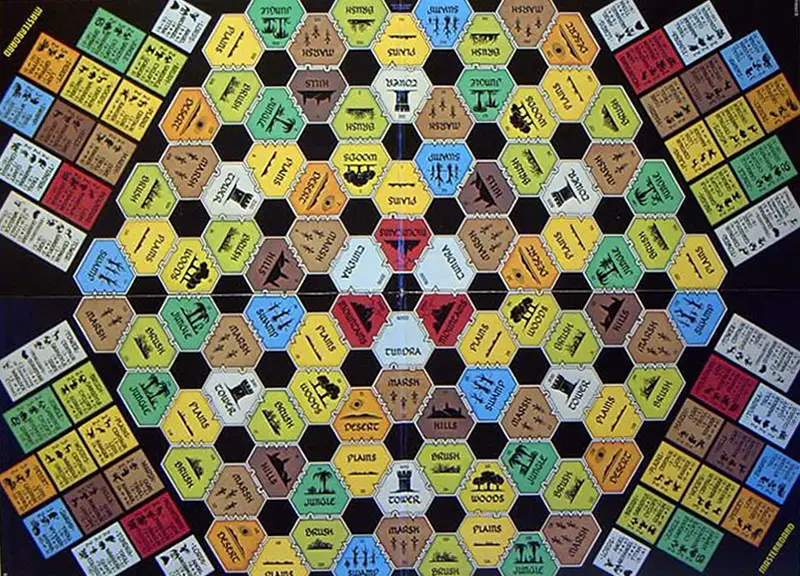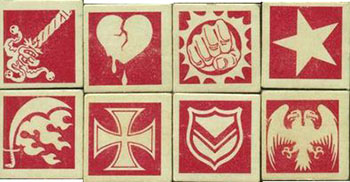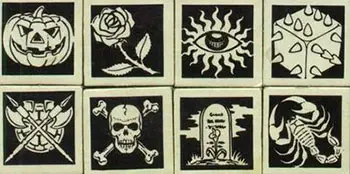

The masterboard is the game map where the strategic level of TITAN is played. The Masterboard is a network of 96 spaces, divided among 11 different types of terrain. Each Land is named and numbered for easy reference.
The Lands are connected by Signs set on their interlocking borders, which regulate the movement of Legions around the Masterboard. The blank areas on the board are voids that Legions may not cross nor enter.

The battlelands are displayed on the front and back of six separate sheets. They are the arenas of Battle. Each Battleland depicts one of the 11 types of terrain of the Masterboard and is divided into 27 hexes.
Some of these hexes contain hazards, which may affect the movement and combat ability of the characters.
TITAN includes cardboard playing pieces, divided into character "counters", damage chits, and Legion Markers. Legion Markers are identified by a unique pictogram.
There are six color-coded sets of 12 markers, each with a corresponding Titan counter. The other counters represent the various characters in the game.
Characters
Characters are the basic units of the game, which make up each player's forces. They are organized into Legions on the Masterboard, but maneuver and fight separately when deployed for Battle on a Battleland.
Characters can be of three classes: Lords, Demi-Lords, and Creatures. All of the different characters in the game are listed on the Character Chart. Note that Titans are color-matched to Legions and each player will have one set.
The rest of the characters in the game are "generic" in that any player can use them. Ownership is defined by the Legion marker.

Lords are divided into three types: Titans, Angels, and Archangels. Each player begins the game with one Titan and one Angel. More Angels and then Archangels may be acquired as the game continues.
A player may never have more than one Titan in play. Lords possess the special power of teleportation. As mentioned above, if a player loses his Titan, he is out of the game.

Demi-Lords come in two types: Guardians and Warlocks. They can only be recruited in Tower Lands on the Masterboard. They differ from Creatures in that they are returned to the caretaker's stacks when they are destroyed and can be mustered again. Warlocks possess some special powers used in Battle.
Creatures are the other 19 types of characters that can be mustered from the various terrains of the Masterboard. Creatures- such as Ogres, Lions, and Dragons- form the bulk of the player's forces. Once slain, Creatures are permanently removed from the game.
Each character counter displays the character's name, its silhouette, its Battle-factors, and symbols denoting special abilities (if they have any).

Legions

Legions are the basic formations of play for the strategic area of the game, Masterplay. Each Legion is comprised of a group of character counters stacked underneath a Legion Marker of the owning player's color. Each Legion is placed on one of the Lands of the Masterboard, with no more than one Legion per Land.
Legions move (and engage in combat) as a single entity. A character cannot be moved on the Masterboard except as a member of a Legion; Legions cannot drop characters off, although characters can be split from Legions to form new Legions
Legions may contain a maximum of seven characters, and a Legion that has seven characters is considered to be "full". A "full" Legion cannot muster or summon other characters. Full Legions may continue to move normally and may be teleported.
If at any time a Legion is found to contain more than seven counters, its characters are immediately revealed and its largest Creatures (by value) are eliminated until it has no more than seven characters (if it lacks Creatures, remove Demi-Lords, then Archangels, then Angels). It is then returned to its Land.

Each player receives a color coded set of 12 Legion Markers, which allows him to have up to 12 Legions on the Masterboard at any given time. A player can add a Legion to the Master- board only if he has a marker available that is not already in play and is able to split one of his Legions. To be able to field more than 12 Legions, a player must eliminate another player, thereby gaining the use of the eliminated player's Legion Markers.
When a Legion splits, both the old and the new Legion must contain at least two characters, and all of the characters that they contain must have been in the old Legion before the split.
The new Legion's characters are removed from the old Legion and placed beneath their own marker; players do not reveal which characters they split off. The new Legion stack is considered to be in the same Land as the old Legion,
But one of them must be moved in that game-turn, if possible. They may both be moved, but they may not move to the same Land. If neither can move due to the presence of other friendly Legions, the new Legion is aborted and all of the characters remain in the one original Legion.
Note that it is also possible to split a sufficiently large Legion into three Legions, each composed of at least two characters. Legions must be split before the die is rolled and Legions move, and it is possible that not all three Legions will be able to leave the area where they split. After all Legion movement takes place, if an area where Legions split still has more than one Legion, it must recombine into a single Legion.
Any Legion that loses all of its characters is eliminated; its marker is returned to its owner, who may use it again when he wishes to start another Legion.
he character counters in a Legion are stacked face down on the Masterboard, underneath the Legion Marker, so that even if a stack is disturbed, its character are not revealed. To avoid confusion, player who wishes to examine one of his own stacks should leave its Legion marker on the Land which it occupies as he does so (and should only examine one stack at a time).
Continue Reading
